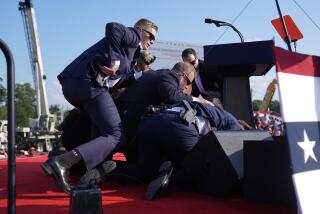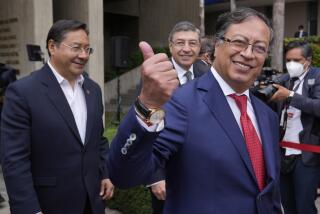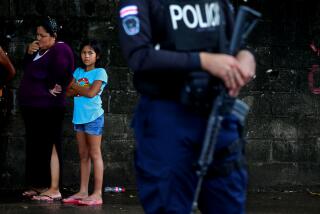Secret Service Faces a Tough Task in Cartagena : Security: U.S. agents have prepared three secret routes to safely deliver Bush to a drug summit. There are reports of death threats.
- Share via
WASHINGTON — Facing what a security source called “one of the hardest assignments” in its history, the Secret Service has prepared three secret routes for safely delivering President Bush to the Andean nations’ drug summit in the violence-plagued Colombian resort of Cartagena, a White House official said Tuesday.
Despite frightening reports that the President may be targeted for death by the cartels, Bush has been adamant in his determination to carry out the mission--a quick get-together with the presidents of Colombia, Bolivia and possibly Peru on Feb. 15 to talk about the drug plague that begins in the coca fields of the Andes and ends on the streets of North America.
The President and his aides assert that it is important for him to show that he stands with the government of Colombian President Virgilio Barco Vargas. But there remains a degree of concern about whether the risk is as great as some suggest, and whether Bush should make the journey.
Bush’s insistence on pressing ahead with the meeting, said a former senior government official, carries with it more than simply a commitment to Barco, which Bush is said to feel very strongly.
“It demonstrates one more time that he’s not a wimp--he’s macho man. Everybody says, ‘Don’t go; it’s too dangerous.’ He’s going to show them,” the former official said. But, he added, there’s another “perception around town--that it is grandstanding.”
While plans for the visit remain fluid and to a large extent secret, a senior White House official said the Secret Service has decided that it can provide the needed security for Bush and has proposed three possible modes of transport and routes for him:
Flying directly to Cartagena aboard Air Force One and then transferring to a Marine Corps helicopter for a short trip to the meeting site. Air Force One is equipped with sophisticated electronic countermeasures to defend against missile attacks and can be accompanied by a protective deployment of U.S. fighter jets. The helicopter that would be used also carries missile defenses.
Flying the night before to a nearby country and then making a short helicopter flight directly to Cartagena on the morning of the meeting.
Flying by helicopter to a U.S. warship in the Caribbean and then sailing to Cartagena, which was once the principal Spanish port in Latin America.
Unverified reports about threats to the President have been hair-raising.
By one account, drug barons have offered $30 million for the assassination of Bush. By another, they are trying to buy surface-to-air missiles to try to shoot his airplane or helicopter out of the sky.
But the Medellin cartel, best-known of the cocaine organizations, issued a statement late Monday denying that it either has plans to kill Bush or that it has sought to buy missiles for that purpose.
In recent years, Cartagena had been relatively peaceful when compared with Bogota, the capital, and with Medellin. But the calm that gave the old port city an air of security in violence-prone Colombia was shattered when four bombs exploded during a three-month period late last year. One bomb at the Hilton Hotel killed two Colombian doctors.
White House aides and others close to Bush say he will not back down in the face of the potential threats, even though the pros and cons of such a visit have been weighed at the White House. They compare his resolve to his initial refusal to change his plan to meet with Soviet President Mikhail S. Gorbachev on the storm-tossed cruiser Belknap anchored in a Malta harbor during last December’s summit conference, rather than on the more stable Soviet cruise ship tied up securely at a pier.
“As far as I know, there has been no suggestion from the top that this is a no-go,” said White House communications director David Demarest. “Yes, we’re going, and that’s it.”
The more frightening rumors aside, a variety of government sources said there is indeed a risk involved in the trip, during which Bush would spend no more than half a day in Cartagena. Most of that time would be spent within the heavily protected confines of a Colombian naval base. The base is home port for two submarines, five corvettes, a dozen small gunboats and a brigade of marines.
While some White House officials who have made several advance trips to Cartagena reported that the danger does not appear as great as some in Washington indicate, one government security agent with more than 25 years’ experience said of the mission facing the Secret Service: “This could be one of the hardest assignments they’ve ever faced.”
This is not the first time Bush’s travels have challenged the Secret Service.
Two days after the bombing of the U.S. Marine Corps barracks in Beirut in October, 1983, the then-vice president was driven to Andrews Air Force Base outside Washington in an unmarked car--not the black limousine or Marine Corps helicopter he would normally use for such a trip--and was flown aboard Air Force One and then a military C-130 transport to Beirut, in an unannounced visit.
His attitude in such situations--from Beirut to Cartagena--is that if the Secret Service cannot provide the necessary protection, “then call in the Marines,” one adviser said. “If the President says we’re going, then they’ve got to find a way” to provide the necessary protection.
Times staff writers Don Shannon and Ronald J. Ostrow, in Washington, and William R. Long, in Rio de Janeiro, contributed to this report.
More to Read
Sign up for Essential California
The most important California stories and recommendations in your inbox every morning.
You may occasionally receive promotional content from the Los Angeles Times.













